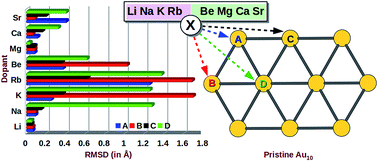Dopant induced modulation in the structure and electronic properties of Au10 cluster†
Abstract
The dopant driven strong modulation of the physiochemical properties of metal clusters has attracted a wide research interest due to its potential application in sensing, catalysis and medicine. In this work, the perturbation of doping atoms, belonging to the alkali and alkaline earth metal groups, on the Au10 cluster has been unraveled by studying the electronic structure and stability of these metal clusters. Our density functional theory based calculations show that a planar to 3D transition can be induced in Au10 by doping it with a dopant of large atomic radius. A considerable deformation in geometry is also observed on doping the pristine cluster with a dopant which is smaller than the cavity size of the doping position. These dopants lead to electronic modulation of the cluster resulting in better charge transfer potential which is quantified by analyzing the HOMO–LUMO gaps, vertical electron affinity and ionization potential of the pristine and doped cluster. Natural population analysis suggests a charge transfer interaction between the dopant and gold atom. There exists a dipole moment in all the doped clusters, whereas the pristine cluster has a zero dipole moment value. These results suggest that the doped clusters are better potential candidates for use as heterogeneous catalysts, where the dopants serve as tools to tune the catalytic efficiency of the system.


 Please wait while we load your content...
Please wait while we load your content...